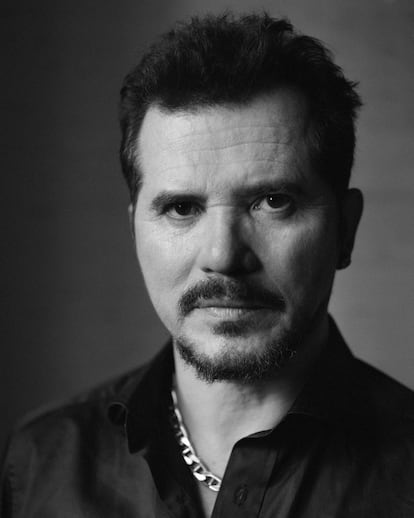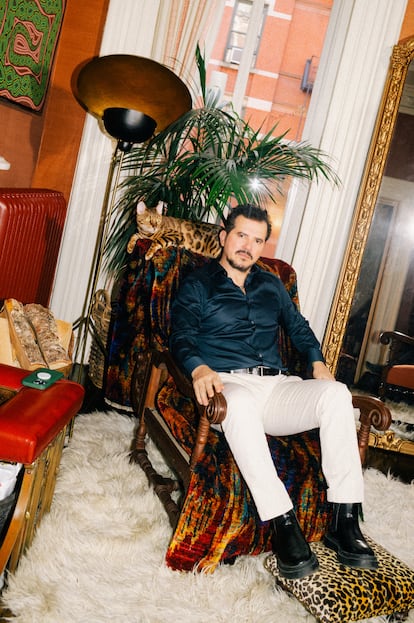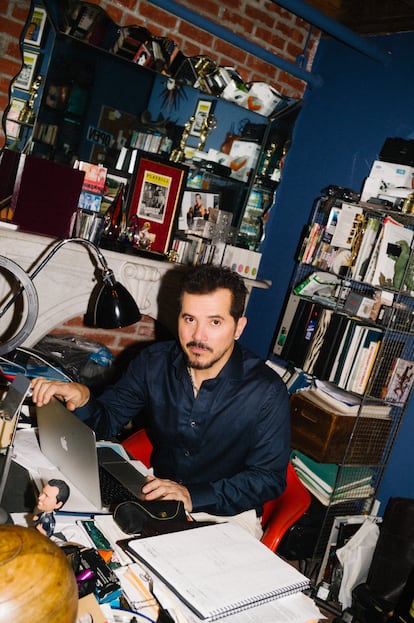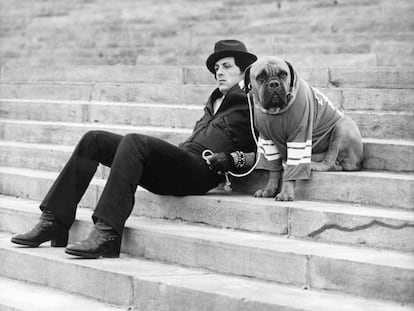John Leguizamo: ‘Playing an Italian was my revenge. If they’re going to steal roles from me, I’m going to steal them too’
For decades – long before it was fashionable – the veteran Colombian actor was demanding that Latinos receive more visibility on screen. Now, as he receives EL PAÍS in his residence, he emphasizes that in ‘The Power’ – the new TV series that he’s a part of – there’s more diversity than ever


John Leguizamo drives his car, wearing a suit and tie. He looks like he’s going to a wedding. The skyscrapers of New York City parade before the 62-year-old Bogotá-born actor, until they disappear. “We’re going to the beach,” he says. For work, or pleasure? “Both – why not mix them? I’m lucky to be able to enjoy my work, so I can call it pleasure.”
Leguizamo is one of the great supporting actors of our era. He’s not as well-known as a big Hollywood star, but he’s never stopped working: he has more than 100 movies listed in his filmography. And, if you’re a movie buff, his face is very recognizable. Some of Leguizamo’s appearances include Carlito’s Way (1993), Romeo + Juliet (1996), Spawn (1997) and Moulin Rouge (2001). More recently, he voiced the male lead in Encanto (2021), where his character, Bruno, was in the chorus of the Disney’s biggest musical hit in recent years, We Don’t Talk About Bruno.
Now, he’s in a new TV series on Amazon Prime Video called The Power. It just premiered a few weeks ago, and it has an unbeatable premise. Suddenly, all the teenage girls in the world develop the power to electrocute people with their fingertips. In this case, revenge is a dish best served hot.
In the show, Leguizamo is the male lead — a doctor who is married to the mayor of Seattle (played by Toni Collette) and whose daughter also develops these powers. His character is Latino: sometimes he speaks Spanish with his daughter and sings along to reggaeton in his car. But in The Power, Leguizamo isn’t reduced to his Latin identity, unlike in many other productions he’s been a part of.

“[The character I play] is a normal guy who loves his kids and his wife… [He’s] someone who tries to survive in a complicated world using a sense of humor. In the script, there are many scenes of daily life that I really like to find in movies… And they’re especially rare if a Latin guy like me is playing the role,” he says.
For years, Leguizamo has been very rebellious in this regard, demanding more representation and recognition for Latinos in Hollywood. “In my 40 years in the industry, I’ve tried to launch a lot of projects with Latino characters… [But] they don’t get off the ground. I’ve heard lots of excuses. There’s a market, there’s talent… There are Latino actors who’ve had great success, such as Pedro Pascal in The Last of Us, or the cast of Hamilton on Broadway. Only the ‘yes’ from the executives is missing. And, if we [don’t get a yes], we’ll have to start organizing boycotts and protests.”
“A decade ago, an executive told me: ‘We don’t have to pursue the Latino audience, because the Latino audience already comes to us. We already have your money.’”

Leguizamo was born in Bogotá, but his parents immigrated to New York when he was very young. This perhaps explains the Spanglish that he uses during this interview. He grew up in Jackson Heights, Queens, surrounded by friends (“almost all Black and Latino,” he recalls) who had trouble pronouncing his last name. It should be pronounced — according to its Basque origins — Le-gui-za-mo.
“My agents suggested that I give myself an Italian last name, so that people would believe that I was Italian and not Latin. I have a Latina friend who submitted her photos to different castings, some with her Latin name and others with an American name. She got callbacks to the ones that received her American name. That’s how things work here. Bruno Mars changed his name! Why didn’t he keep his last name (Hernández)?”
“But I refused, I would never do that. I would rather not find a job than pretend to be someone else,” he says.
He did end up finding jobs in Hollywood. But exactly what kind of roles did he get? Well, he played a drug dealer, a terrorist, a gangster… In Regarding Henry (1991), he shot Harrison Ford twice, which is almost like shooting America. In Carlito’s Way (1993), he shot Al Pacino three times, which is like shooting up the Actor’s Studio.
“At first, you’re delighted to be able to pay your bills… But there came a point when I no longer wanted to do those roles. I remember that I walked out [of a meeting] when I was asked to play a terrorist [for the second time] in another hijacking movie.”

He was, in his own way, a very early defender of causes that, many years later, began to be heard. The results of the struggle for diversity are visible today at the Oscars, where Asians, Latinos or African-Americans compete equally with Caucasian stars.
“I’ve always been fighting the system. I remember feeling helpless watching so many of my incredibly talented Latino friends unable to land a single role. That’s why I shifted to the theater. There, in comedy clubs, in performance spaces, I was able to find my place. And I realized that white people loved my humor. I experienced how I won over the white public; I knew that I was going to be successful! The difficult thing was to convince those who had the power and the money.”
During one of those performances, something marked him profoundly. It was the year 1990: Leguizamo was doing the monologue for Mambo Mouth — his Broadway debut — and Arthur Miller was in the audience. “I was aware that very interesting people had begun to come to see me. So, at the end of each performance, I would go out and greet the audience.” In addition to Miller, he met fans such as Sam Shepard and Al Pacino (before he shot him three times).
Once, he met Robert de Niro after a performance. “I could barely talk… And he doesn’t talk much, so neither of us spoke. We just smiled at each other.”

If we dive into the beginning of his career, other icons appear. One from the world of pop art — Paul Morrisey — gave him his first minor role, in Mixed Blood (1984). The year before that, he was in one of Madonna’s music videos, for the song “Borderline.” If you look it up on YouTube, you may catch a glimpse of Leguizamo, lost among the dancers.
“I was 24-years-old and I had taken the [screen] tests. They didn’t pay us — they just gave us a sandwich, coffee and water. I left with the fantasy of being discovered, of being liked by Madonna... The things that go through a young boy’s head! In the end I couldn’t even talk to her; the other extras were taller and more handsome. They pushed me aside.”
The singer and the actor have met again. When they did, he told Madonna that he was one of those young guys in the video clip. “She didn’t remember me!” he laughs.
There was a movie in 1993 that seemed destined to make Leguizamo into the first Latino A-list star. It was called Super Mario Bros. He played Luigi. With a multi-million dollar budget and a legion of video game fans awaiting it, the movie seemed destined for global success. But it didn’t pan out. In fact, it was one of the greatest Hollywood flops of the 1990s. For years, Leguizamo didn’t want to remember it. “I expected it to be a success, a great movie. And when we saw it...”
But years later, something changed. “When the reviews are that bad, they end up influencing the idea you have of your own film. Later, I realized that, at events like ComicCon, a lot of kids would come up and tell me that Super Mario Bros was their favorite movie, that it had been important to them. I started to see it in a different way.”
By the way, in the film, he wasn’t playing a Latino: he was an Italian plumber. “White American actors have been taking Latino roles away from us for decades! Remember Charlton Heston in Touch of Evil? And Al Pacino did it twice [in Scarface and Carlito’s Way]! For me, playing an Italian was my revenge. If they’re going to steal roles from me, I’m going to steal them too.”
Sign up for our weekly newsletter to get more English-language news coverage from EL PAÍS USA Edition
Tu suscripción se está usando en otro dispositivo
¿Quieres añadir otro usuario a tu suscripción?
Si continúas leyendo en este dispositivo, no se podrá leer en el otro.
FlechaTu suscripción se está usando en otro dispositivo y solo puedes acceder a EL PAÍS desde un dispositivo a la vez.
Si quieres compartir tu cuenta, cambia tu suscripción a la modalidad Premium, así podrás añadir otro usuario. Cada uno accederá con su propia cuenta de email, lo que os permitirá personalizar vuestra experiencia en EL PAÍS.
¿Tienes una suscripción de empresa? Accede aquí para contratar más cuentas.
En el caso de no saber quién está usando tu cuenta, te recomendamos cambiar tu contraseña aquí.
Si decides continuar compartiendo tu cuenta, este mensaje se mostrará en tu dispositivo y en el de la otra persona que está usando tu cuenta de forma indefinida, afectando a tu experiencia de lectura. Puedes consultar aquí los términos y condiciones de la suscripción digital.
More information
Archived In
Últimas noticias
Alain Aspect, Nobel laureate in physics: ‘Einstein was so smart that he would have had to recognize quantum entanglement’
Imelda Castro, the woman who wants to rule the cartel battleground of Sinaloa
The new victims of the Republican war on Obamacare: Millions hit by soaring health insurance premiums
A country divided on migrant rights: Some US states expand protections while others restrict them
Most viewed
- David King, chemist: ‘There are scientists studying how to cool the planet; nobody should stop these experiments from happening’
- Reinhard Genzel, Nobel laureate in physics: ‘One-minute videos will never give you the truth’
- Oona Chaplin: ‘I told James Cameron that I was living in a treehouse and starting a permaculture project with a friend’
- Sinaloa Cartel war is taking its toll on Los Chapitos
- Mexico completes its trade shift with the entry into force of tariffs on China and countries without trade agreements










































